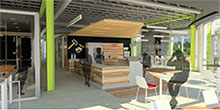January 22, 2016
APDesign student lands first prize in NEXT competition

Kansas State University College of Architecture, Planning & Design received notification that Caleb Amundson, a fourth-year student in interior architecture & product design, Shawnee, was awarded top honors as the finalist in the NEXT Student Design Competition on Jan. 15. Amundson won the $2,500 award and another $2,500 for APDesign. He also won a custom-made Think Chair from the competition's sponsor, Steelcase Design Alliances.
The NEXT competition had more than 700 students from 60 programs participate from around the U.S.
Steelcase said, "As a reminder of our anonymous judging process, each professor submitted two submissions from their independently taught studio class via an external Gmail account to a third party consultant in California. This consultant renames each entry using a random number/letter code — 14N or 71SS — and then distributes submissions via Dropbox and ensures each judge receives a mix of programs to review. Judges score entries individually and then meet face to face. Each judge presents his or her pool of entries to the other judges and all judges vote after each review. This review process is inclusive of a full day of reviewing entries, voting/re-voting and debating amongst the judges to align on the five semi-finalist and five honorable mention projects against the program criteria. At that point, identification codes are documented and we receive the spreadsheet and only then are the names of the students and their corresponding programs revealed to everyone at the same time."
Judges for the competition were Verda Alexander, O+A, San Francisco, California; Vanessa Bradley, Steelcase Inc., Grand Rapids, Michigan; Frances Bruns, Interior Architects, Dallas, Texas; Joyce Fownes, Perkins and Will, Atlanta, Georgia; Takehiro Nakamura, Perkins Eastman, Washington D.C.; and Georgia Rappole, Steelcase Inc., Atlanta, Georgia.
This is the second year in a row that a K-State APDesign student won the NEXT Student Design Competition. In January 2015, Emma Montgomery, Sabetha, a current fifth-year graduate student in interior architecture and product design, won the competition.
Before Amundson won the competition, he and four other semifinalists, one of whom was Alex Marschman, a fellow fourth-year student in interior architecture & product design, Lenexa, were sent on an all-expense paid trip to Grand Rapids, Michigan. There they presented their designs for a collaborative workplace to a panel of judges at Steelcase University.
"The experience in Grand Rapids was one of the best in my college career. I am so glad to have been held in the same regard as the other semi-finalists — each extremely talented and kind. I learned a lot about the Steelcase brand, made connections with professionals, and found quick friendship with the other semifinalists," Marschman said.
"I am so thankful for all of the opportunities we have had to present our projects throughout our time in interior architecture and product design, especially in front of professionals. I had no idea what to expect at Steelcase, and I was completely blown away by the hospitality and genuine desire exhibited by each of the judges and Steelcase employees to get to know each of the participants," Amundson said.
Of all the submissions in this national competition, K-State's interior architecture & product design students comprised three of the top 10, including one of the five honorable mentions, Garrett Steinlage, fourth-year student in interior architecture and product design, Seneca, and two of the five semifinalists. The competition provided a building shell and challenged students to "create a coworking environment fostering a sense of community, where ideas are shared, collaboration flourishes and relationships are built — allowing entrepreneurs, freelancers and businesses to be flexible, collaborative and focused on end results."
The competition's webpage, highlights Amundson's project as well as the semifinalists' work.
Christopher Manzo, visiting professor in interior architecture & product design, was Amundson's and Marschman's studio professor while they were working on their contest submissions. Manzo said he was impressed by the professional skill level his students possessed.
"Their work process is phenomenal," Manzo said. "If they were to work at a firm now, they would do just fine. They're both incredibly creative."
Kathy Ankerson, professor and interior architecture & product design department head, said, "We are incredibly honored to have Caleb's work recognized in this way, and proud of each of the interior architecture & product design students representing the department and participating in the competition. The number of students we had in the top 10 provides recognition of the quality of our students and faculty and our approach to design education."
